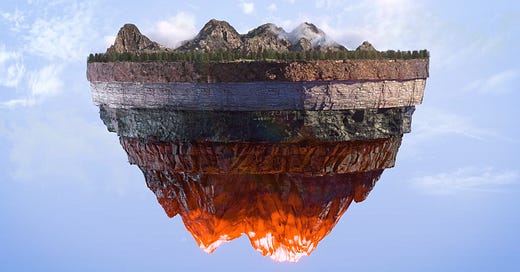Going deep with Quaise
As we drill into the earth from the surface, we travel through layers of sedimentary cover and eventually hit basement rock. Basement rock is ancient and hard. Usually, it’s granite.
Drilling through basement rock is harder than drilling through the sediment. In part, this is because granite itself is harder than sedimentary rocks. Mechanical drill bits are more likely to break against very hard rocks. But also, drilling deep as such is also challenging. Today’s mechanical drills, optimized for oil and gas requirements, can’t long withstand the high temperatures and pressures associated with very deep wells. Making matters worse, every time a drill bit breaks, the entire drill string needs to be pulled out of the ground and replaced, a process known as tripping. The delays and costs associated with tripping increase as the hole gets deeper. If you want to reduce the cost of drilling really deep holes, you need a drilling system that doesn’t break as it comes in contact with granite, can handle high temperatures and pressures, and that doesn’t require tripping.
What if we lived in an amazing sci-fi future, or perhaps a long time ago in a galaxy far, far away? Could we not construct some sort of giant light saber to replace mechanical drill bits? Is there a way to use pure energy to obliterate the granite?
That is what Quaise Energy is working on. The company is developing a drilling system that uses gyrotron-generated mm-wave directed energy to vaporize granite.
The prize if Quaise succeeds is that high-efficiency geothermal energy becomes available everywhere on the planet. No matter where you are on Earth, if you go deep enough, it is hot. To reach the 500ºC temperatures Quaise is focused on, they may have to drill to a depth of 3–20 km, depending on the geology. This whole depth spectrum becomes possible with a cost-effective way to drill through granite.
Reaching 500ºC temperatures is critical. In fact, forgive the pun, it is supercritical. When water is heated and compressed above 374ºC and 218 atmospheres, it becomes a supercritical fluid with unfamiliar properties. Among these is that its enthalpy goes up significantly compared to water in its ordinary liquid or steam forms. This means that it becomes a better carrier for heat energy. By targeting 500ºC heat at depth, Quaise reckons they will be able to produce supercritical steam at the wellhead.
What would we do if we could produce supercritical steam anywhere on the planet? At a minimum, we would get rid of the boilers at coal-fired power plants. These boilers burn coal to produce supercritical steam to feed into the turbines that then produce electricity. But if we could produce supercritical steam from the ground without boilers, we could convert our dirty coal plants into zero-carbon electricity sources by simply piping the steam from the ground into the turbines.
In addition to being great for our climate, this move makes excellent business sense. Re-using coal turbines from plants that would otherwise retire saves money. So does locating on a site that already has the necessary generating permits and connections to the grid. Producing electricity in this way could be extremely cheap—cheaper even than wind and solar, yet with the reliability and density of fossil energy.
Quaise today announced that they have raised a $40 million Series A. I’m pleased to have invested in the round through my syndicate, and I’m excited to follow along as they unlock the true power of clean geothermal energy.
If you are interested in investing with me in companies like Quaise, be sure to check out my AngelList syndicate.




